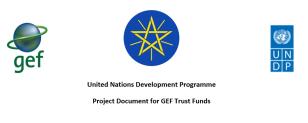FOLUR project documents including safeguards for public consultation
FOLUR project documents including safeguards for public consultation
October 31, 2022
*** If you have any questions or comments, please email us on communication.et@undp.org
Context
Ethiopia’s rural areas face many interconnected development challenges, with additional stresses experienced in 2020 from locust swarms and the COVID-19 pandemic, causing health impacts, disruptions to agricultural supply chains, job losses and food insecurity (see Annex 9a for full analysis of COVID-19 impacts and responses). The key development challenge to which this project responds is continued environmental degradation in Ethiopia’s 9 million hectare coffee-producing area in the southwest of the country in Oromia, Southern Nations, Nationalities and Peoples’ (SNNP) and Sidama[1] Regions, home to approximately 15 million small-scale family farms. Without scaled up interventions to address the underlying trends, this degradation will continue, leading to ongoing rural poverty and inequality amongst small-scale farmers of these Regions. Immediate causes of poverty include low agricultural yields, and limited incomes from production of commodity crops, including coffee. Over time, degradation and loss of forest cover may also affect the ecosystem services upon which agriculture depends. The problem analysis diagram below shows the complex interrelationship between poverty and environmental degradation. In addition to the negative impact of loss of topsoil, declining soil fertility and degradation of forest on farming incomes, poverty is also a cause of degradation, since farm households without access to knowledge, finance and equipment for agronomic best practice are driven to expand low-yield production further into the forest.
Between 1973 and 2005, the conversion of forest-land into crop-lands in Ethiopia’s Afromontane rainforests led to a reduction in forest coffee and semi-forest coffee systems from 71% to 48% of the original coffee stands. The moist forest ecosystem is the centre of origin and diversity of Coffea arabica; the only ecosystem in the world where C. arabica plants exist in wild conditions with a diverse gene pool. Other cropping systems present in these coffee landscapes lead to ongoing conversion of forests to grow crops such as maize, wheat and khat. Evidence also shows that wild coffee forests have become increasingly disturbed and fragmented due to forest conversion to settlements and agricultural land, and forest modification by timber extraction and wild coffee management interventions. Ethiopia’s Land Degradation Neutrality report shows that a total of 427,730 ha of forest was lost nationwide between 2000 and 2010, with a further 21,359,490 ha of forest land seriously degraded, and an area of 14,193,615 ha of cropland affected by negative trends of arable land deterioration, through erosion, acidification, alkalization and salinization.[2]
[1] Sidama Region was legally formed on June 2020 as a separate Region, Ethiopia’s 10th Region, with boundaries based on the former Sidama Zone in the Southern Nations, Nationalities, and Peoples' Region (SNNPR), after a Sidama referendum returned a result in favour of increased autonomy.
[2] Federal Democratic Republic of Ethiopia, 2016. Ethiopia - Land Degradation Neutrality National Report

 Locations
Locations
